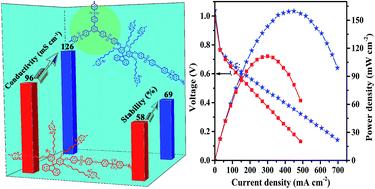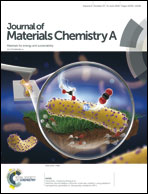Branched comb-shaped poly(arylene ether sulfone)s containing flexible alkyl imidazolium side chains as anion exchange membranes†
Abstract
Anion exchange membrane (AEM) fuel cells are promising for efficient and environmentally benign electrochemical energy conversion. However, the development of high-performance fuel cells requires new AEMs tailored for high conductivity and alkaline stability. In this work, poly(arylene ether sulfone)s with different branching degrees were synthesized as AEM materials. The effect of the branching degree on the properties of the copolymers was investigated in detail. The bulky rigid three-pronged branched structure introduced into the copolymer backbone increased the free volume in the corresponding AEM. As a result, the branched AEM demonstrated markedly improved ionic conductivity (up to 126 mS cm−1) compared with that of the linear copolymer AEM (96 mS cm−1) at 80 °C. The highly branched comb-shaped copolymer AEM also exhibited robust alkaline stability and dimensional stability. Furthermore, a platinum-catalyzed fuel cell based on a highly branched comb-shaped copolymer AEM achieved a peak power density of 160 mW cm−2, which was higher than that of the linear copolymer AEM (111 mW cm−2). These results suggest that introduction of a branched structure is an effective strategy to fabricate AEMs with high performance suitable for alkaline fuel cell applications.



 Please wait while we load your content...
Please wait while we load your content...